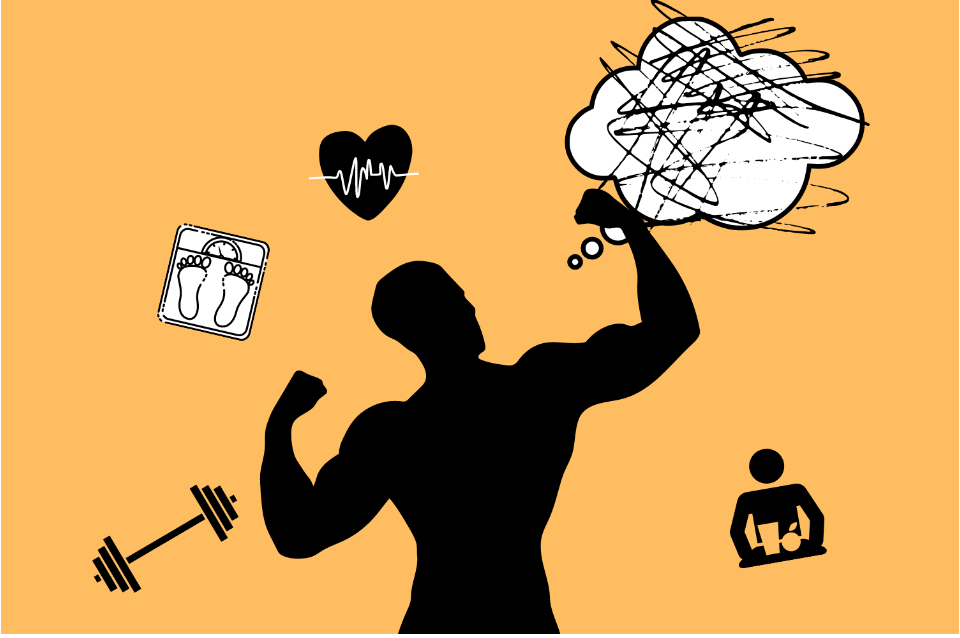Pre-workout, AirPods, hoodies, a pump cover and, of course, a trusty gym partner. Social media gym culture is an interesting place to explore. It spans from toxic to supportive to borderline glamorizing eating disorders, all in the span of a few swipes. The culture differs for both men and women; however, both contain toxic traits that lie hidden between the videos littering social media.
Let’s start with the male “gym bro” culture. It can be an incredibly supportive place, with many teens drawing healthy inspiration from influencers such as Chris Bumstead and Noel Deyzel. Both influencers are often seen as kind influencers, while still promoting an active gym lifestyle. They focus on encouragement rather than humiliation to motivate gymgoers.
Deyzel, unlike many other male influencers, pushes against steroids, is open and honest about how he built his body, and advocates kindness, according to Euronews. Bumstead takes a similar approach to Deyzel, and even though he’s a three-time Classic Physique Olympian champion, he ensures that he is taking care of his body and lives in balance, not only focusing on his physique, according to BarBend.
Other positive fitness influencers create content focused on good form, which is crucial to prevent injuries in the gym. Some also provide workout guides for free, easy recipes, and how to make sure not to push their body to the max.
There is, of course, the healthy “gym-bro” culture, which focuses on positive encouragement for men. It could be seen in the form of having someone spot you and support you if you hit your personal record (PR) or support you even if you fail. It is still focused on progress, but it emphasizes the idea that progress isn’t linear.
That is one side of social media’s male gym culture. Contrastingly, the other side is a darker, crueler place, emphasizing building the ideal physique, which is tied to your worth. One should cut everything off and focus only on the gym, according to this culture. This concept promotes the idea of “go ghost,” meaning to shut everyone off and prioritize the gym, along with other, more extreme views. It can be an incredibly harmful and degrading culture.
Instead of advertising a balanced schedule, this side of gym culture stresses a more toxic masculinity approach. Being the “alpha male,” being uncaring, going to the gym to “make her regret it,” distancing from everyone, etc. All of these are some examples of the messages some social media videos promote. The stereotypical one is often a dimly lit gym with a toned man working out, including a block of text saying something toxic. This is the more psychological aspect that some sides of gym culture offer.
The more physical side of the culture promotes the idea that the only food one should eat to attain a specific physique is chicken, rice and broccoli. No desserts are allowed and certain exercises are only for “the weak.” This is the polar opposite of celebrating the positivity that going to the gym can bring. It focuses only on bringing out the worst in males, especially when there is already a specific stereotype in our society surrounding what it means to be a “man.”
This gym culture makes it seem unmanly to not work out, it makes it seem wrong to not dedicate your life to the gym and makes people who can’t do 100 pushups feel as if they have less worth than those who can. It focuses on nutrition in a way that the development of an unhealthy relationship with food and an exercise addiction becomes inevitable.
Male gym culture can be an incredibly supportive, funny and positive environment, but for teenagers who are impressionable, there are so many videos and influencers promoting the wrong ideas. There is no one right approach to the gym. Some people may go to feel healthier, and some may go for a physique, but shaming people for having different choices and encouraging boys to act in a toxic masculine way will ruin the gym for many, and it’ll extend into how people treat others.
For women, the gym culture is a bit different; however, there are still two overarching sides. There is a positive side, which promotes the idea that health and fitness are for all and can look like many things. Influencers such as Anna Engelschall, Lilly Sabri, Sydney Cassidy and others promote the idea of balance, that one can eat cleanly and work out but also go out with friends and enjoy a treat once in a while.
Furthermore, female fitness promotes the idea that there is nothing wrong with masculine women. In society, a muscular woman is seen as unattractive and manly, but in fitness culture, it can be celebrated and promoted. Positive female influencers also encourage the idea that there isn’t one right body and that the bodies we see so often posing on social media look completely different when that same influencer relaxes their stomach, takes off their makeup and doesn’t have a recent gym pump.
Other advantages of having positive female influencers are that they also consider the impact of a woman’s menstrual cycle on lifting and exercising. For example, women might not be able to lift the same amount of weight the week before their menstrual flow as they had lifted even a couple of days before. This is normal, due to hormonal changes and the body preparing to shed the uterus lining.
These types of considerations in female gym culture are significant and celebrate all body types and all sorts of lifestyles. This side of female gym culture promotes knowledge and understanding of one’s body and how to create a healthier relationship with yourself and the gym. However, just like with males, this culture also has a toxic side.
The biggest problem with female gym culture is that it can sometimes promote the idea that you also have to eat a certain way, look a certain way, want a certain body type, etc. Some influencers promote the idea that all carbohydrates are bad, desserts will ruin progress and you have to eat extremely high protein-based diets. Bread is the enemy, you have to earn your food and you should be shooting for a slim physique, they say.
The ideal body for women is still promoted as a tiny waist, toned abs, toned arms and thick thighs. Social media encourages this standard that not all body types can fit into. Furthermore, many influencers who don’t use science to back up their content often post information that isn’t true about nutrition or exercise. This can be incredibly damaging and dangerous, especially for those who are new to the gym.
Furthermore, working out has become part of certain lifestyle trends. For example, the “That Girl” trend includes daily pilates, yoga or cardio. Incorporating exercise into a routine in order to achieve a certain lifestyle that is unsustainable and untailored to the individual is toxic and unhealthy.
Additionally, just like men, women can promote unhealthy eating habits, posting videos of eating less than 1,200 calories a day, even though the average teenage girl should be shooting for around 2,000 calories per day and active girls should be eating even more, according to the United Kingdom National Health Service.
While there are both negative and positive sides of gym culture for all genders, it is much more positive than negative for women. Women, in general, tend to focus on pushing past the diet trends that gripped the past to promote balance and overall wellness, working out to feel good about themselves. They also try to focus on body positivity much more than men do. However, for both genders, gym culture can be a harrowing place that may seem supportive on the surface but is drowning in toxicity.
If you want to begin going to the gym, do it for yourself. Not for an aesthetic or a physique. Go with a friend and build it into your routine. Go because it genuinely makes you feel good; don’t force it. Next time a video of a darkly lit gym with a toned man explaining why men shouldn’t have emotions shows up on your For You Page, swipe to the next video. Focus on building up and promoting the supportive side of social media gym culture.
By Elektra Gea-Sereti






































































